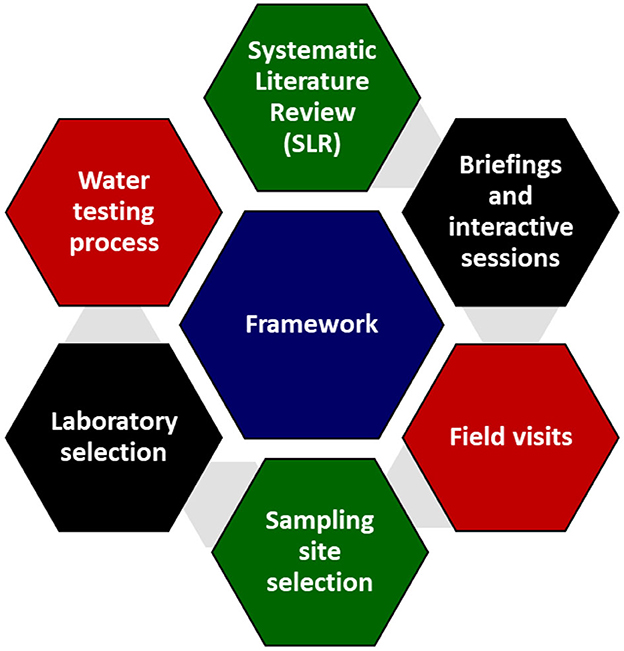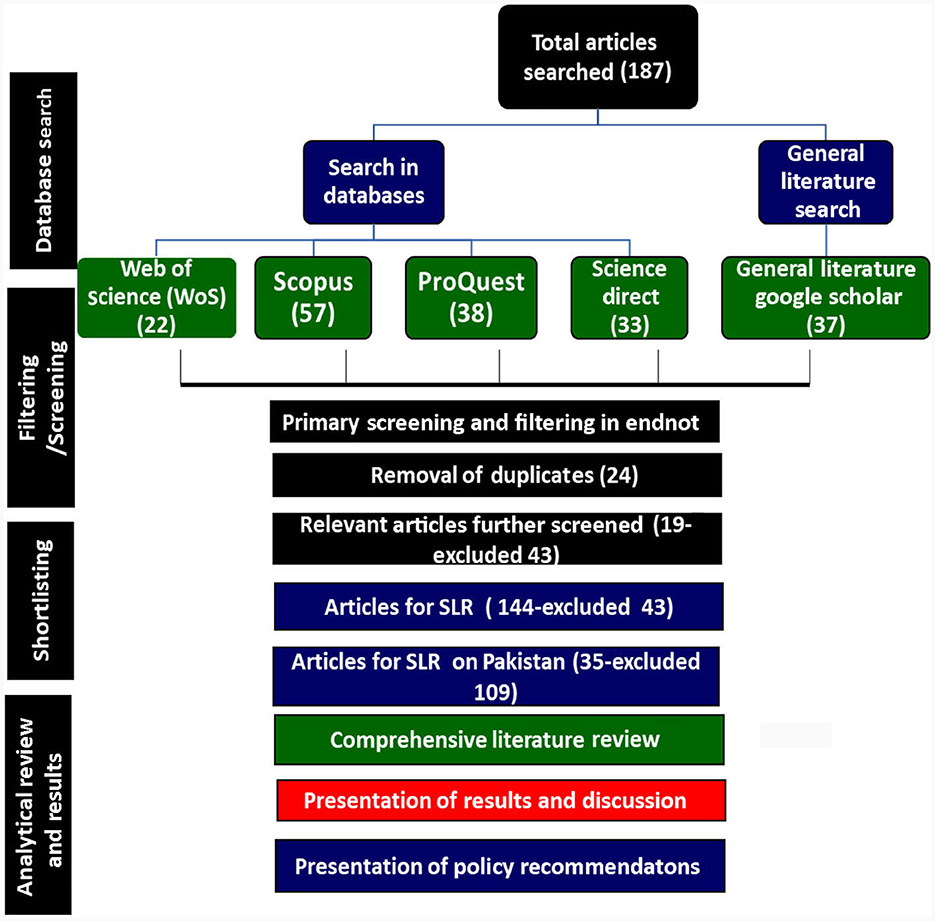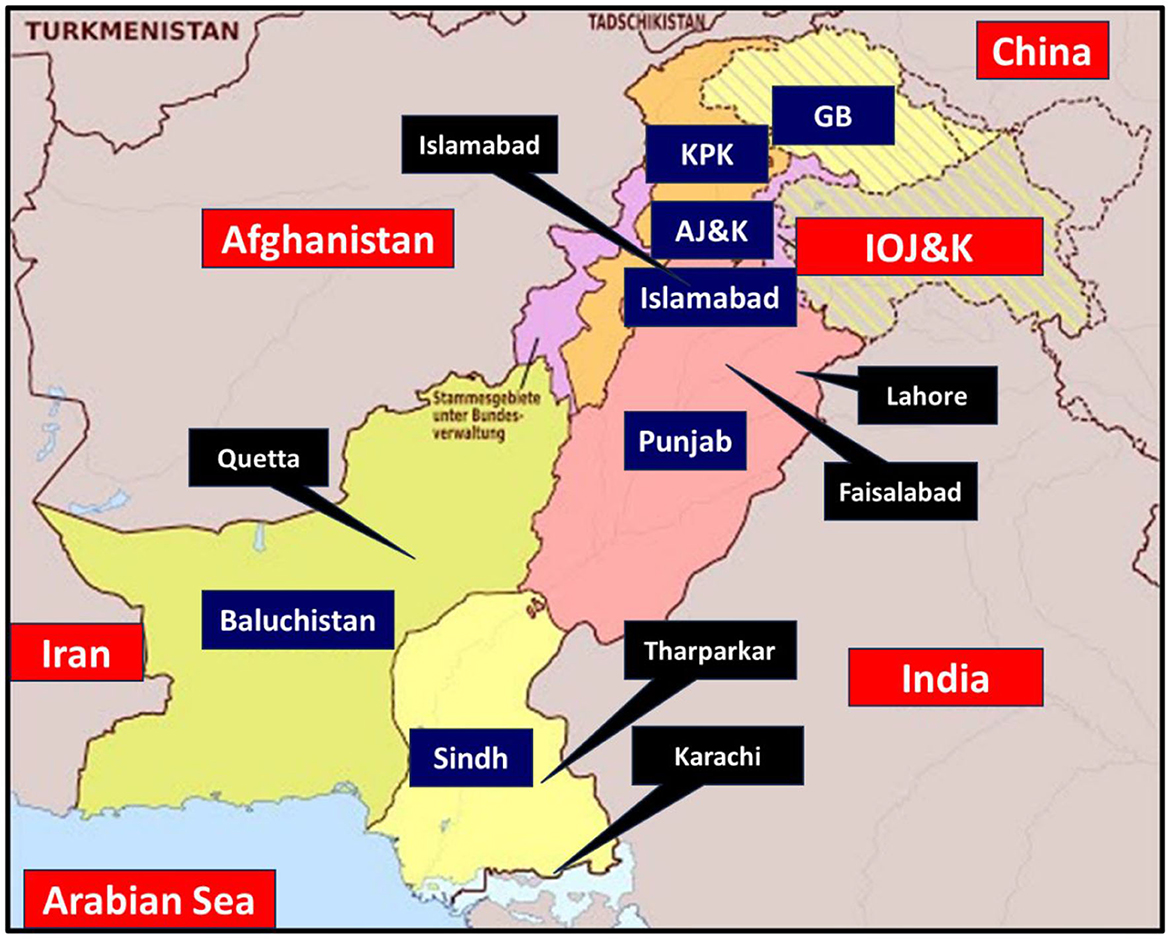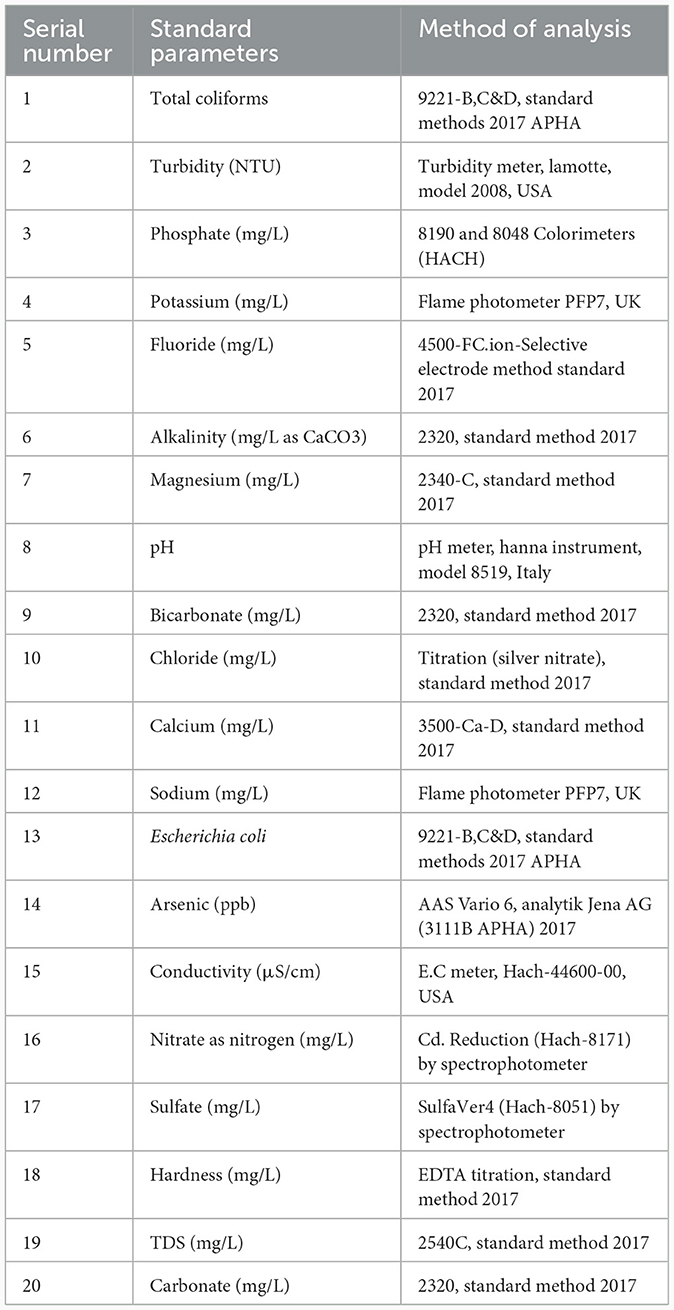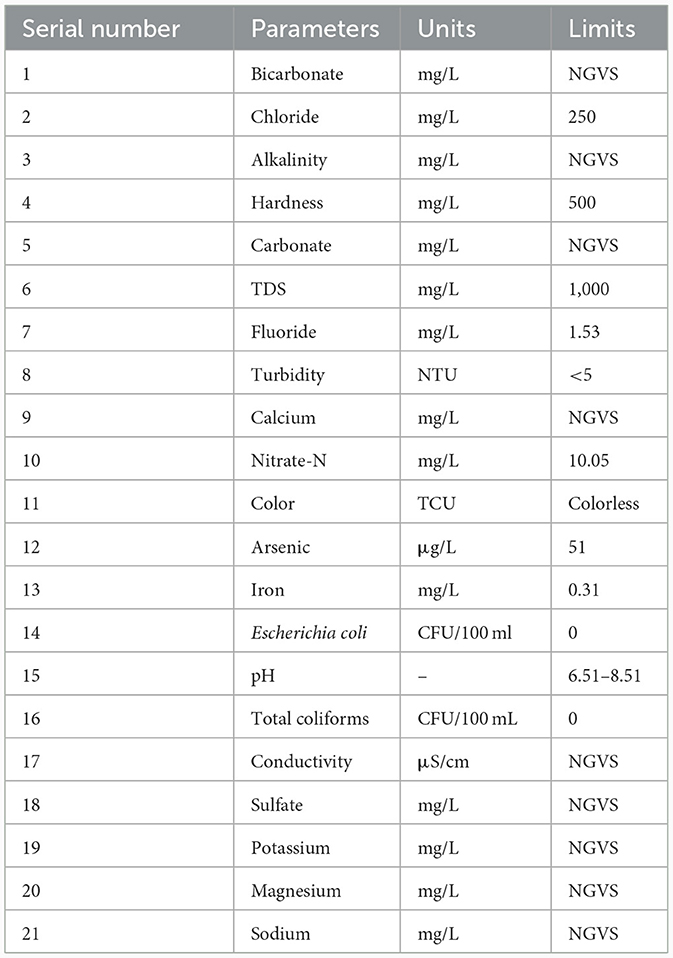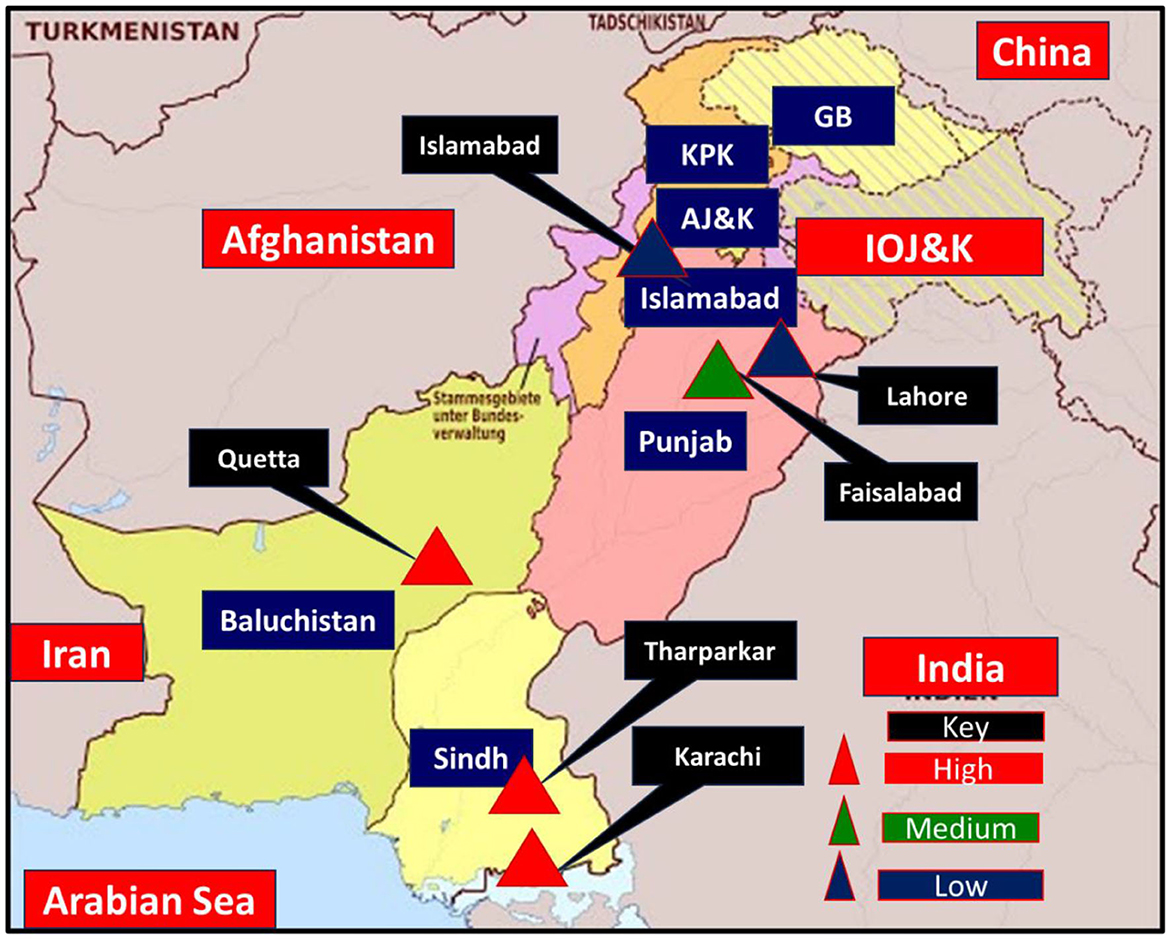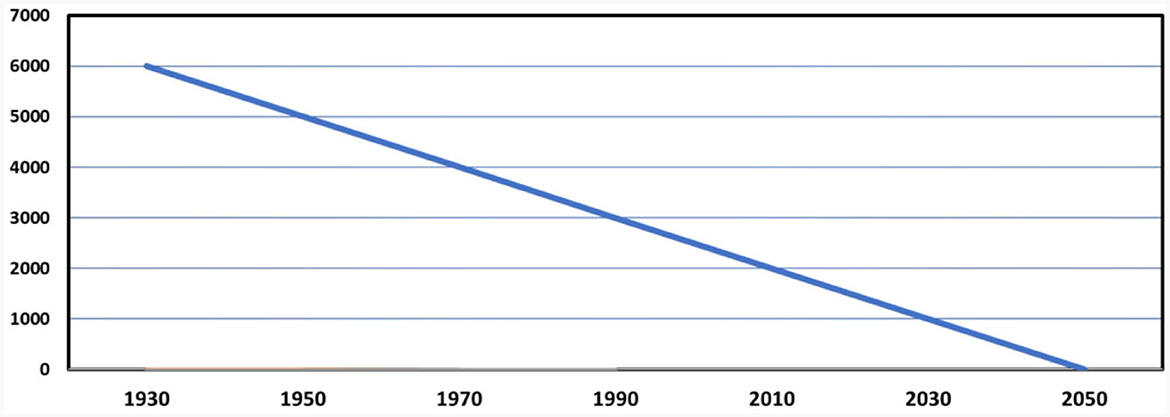- 1China Study Center NUML, National University of Modern Languages (NUML), Islamabad, Pakistan
- 2Dean Social Sciences, National Defence University, Islamabad, Pakistan
Water security is an emerging national security challenge for Pakistan. Combined with water scarcity, the quality of drinking water is rapidly deteriorating; the available drinking water is contaminated for many reasons, impacting the ecological chain in a pronounced way. Despite the government's strong commitment to the provision of clean drinking water to the citizens, and the use of smart technology for irrigation, which consumes 60%−70% of the water, to conserve the available water resources, the implementation of the policy is a daunting challenge. This study argues that surface and subsurface drinking water in Pakistan is being contaminated very quickly, creating several health risks and potential human security issues. The study examines the quality of drinking water through laboratory tests by collecting samples from selected urban and rural areas as a case study and examining them against the minimum safe ranges given in the international and national parameters for clean drinking water. As a result of laboratory testing, it has been revealed that the quality of drinking water in Pakistan is deteriorating sharply and the developing situation, if not addressed in time, has the potential to become the biggest health risk in the coming years. As water quality continues to worsen and water availability is gradually decreasing, the achievement of the United Nations Sustainable Development Goals (UNSDGs) on water by 2030 is becoming a remote possibility. As a timely input to relevant institutions and government ministries, this study comprehensively highlights the challenges of water scarcity and water quality in Pakistan and provides recommendations for addressing the multidimensional water security issues in a sustainable manner and achieving UNSDG number 6 on access to clean water and sanitation for all by 2030.
1 Introduction
Since its independence in 1947, Pakistan has faced several water security challenges (Ishaque and Shaikh, 2017). Throughout the world, water is a chief source of sustenance for plants, animals, and humans. Clean drinking water for the growing population of Pakistan remains scarce and often contaminated, especially in rural areas. For Pakistan, the Indus River System (IRS) is the water lifeline (Pappas, 2011). As the population of Pakistan is growing rapidly, estimated to be 241.5 million in August 2023 as per the recently concluded census (Gallup, 2023), such a rapid increase has put enormous strain on the demand and supply gap of water. Agriculture and livestock consume ~95% of the water in Pakistan which leaves little water with many contaminants for other uses (Khalid, 2017). Out of 122 countries, Pakistan ranks 80th for drinking water availability, which is quite alarming (Azizullah et al., 2011). Water scarcity and contaminated drinking water have become an emerging national security challenge for Pakistan. The construction of water reservoirs remains skewed despite the urgent need, due to a lack of political will, an inability to build consensus, and dwindling fiscal space. Asymmetry in the proportionate allocation of water for irrigation, domestic and industrial usage and clean drinking water has compounded water security challenges (Taimur, 2022). Pakistan receives an average of 200 mm of rainfall from July to September (World Bank Climate Change Knowledge Portal, 2021), but the bulk of the rainwater is wasted due to scarcity of water storage facilities and improper drainage channels for the diversion of rainwater, which eventually ends up in the sea after flooding vast areas of agricultural land as witnessed during the floods of 2022 and 2023. Figure 1 shows that the average annual rainfall in Pakistan has been increasing since 1931, which needs to be considered by the government to build more dams and reservoirs for water storage. As per the provisions of the Indus Water Treaty (IWT), India regularly releases excess rainwater that is discharged through three eastern rivers, but the same amount is also lost as flooding and eventually ends up in the sea (Ishaque et al., 2023).
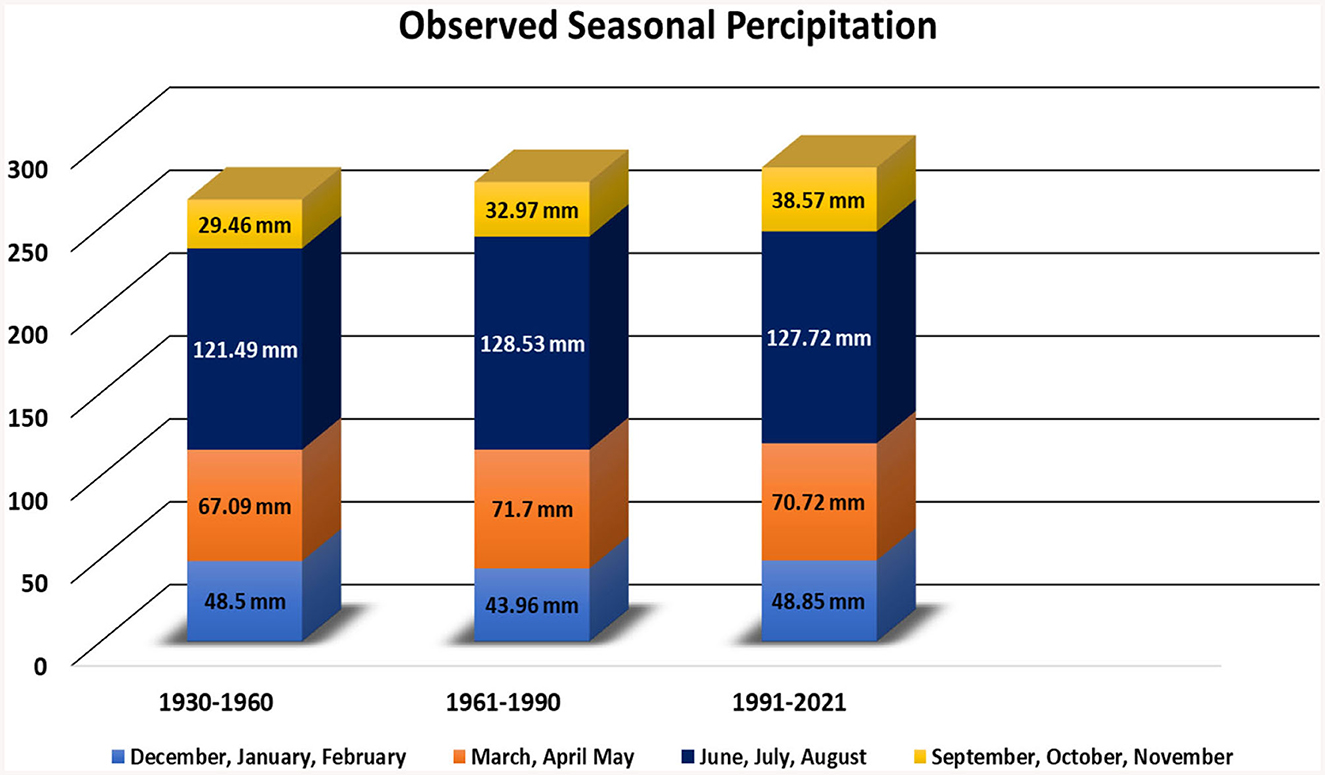
Figure 1. Annual precipitation in Pakistan (World Bank Climate Change Knowledge Portal, 2021).
Pakistan is considered a water-stressed country and is transitioning fast toward water scarcity. The quality of drinking water is also deteriorating at a rapid pace (Ishaque et al., 2022). This evolving situation can have serious implications for the country if the mitigation measures are not initiated in time (Ishaque et al., 2015). A review of the literature from primary and secondary sources reveals that 97.5% of the water that covers the earth's surface is in the form of salty oceans. Freshwater makes up the remaining 2.5%, but < 1% is usable. Secondly, another impediment is the uneven distribution of available fresh water around the globe by the natural systems, when compared with the distribution of the global population, which has a profound impact on water availability in Pakistan (Ishaque et al., 2023). The status of water quality is generally determined by physical and chemical changes that occur over a period of time, such as the impact of segmentation, weather, bedrock, the effects of detergents and pesticides, temperature, runoff, and the impact of pH (Sohail et al., 2022). Globally, the most challenging water quality phenomenon is the presence of high levels of phosphorus eutrophication in the water, which makes it contaminated and unsuitable for drinking purposes. Additionally, the World Health Organization (WHO) has also stipulated guidelines for measuring water quality (WHO, 2022). Therefore, all the above causal factors have been deliberately analyzed while presenting the findings regarding the status of water quality in Pakistan.
Contaminated water has become a buzzword in Pakistan, which can be attributed to numerous factors affecting water quality. The most likely reasons are the increase in temperature, which brings heat to the threshold of drinking water; organic chemicals; microbes; heavy metals, and nutrients (Postel et al., 1996). In Pakistan, water pollution occurs due to geological and natural factors in the form of chemicals, the use of herbicides and pesticides, oil refining, coal mining, improper disposal of garbage, and leakage from septic tanks (Mehmood et al., 2013). Access to clean drinking water in Pakistan, both above and below ground is in a dreadful state. The apathy is equally evident in metropolitan cities and rural areas (Soomro et al., 2011). Additionally, per capita water availability is decreasing swiftly and Pakistan is ranked as a “water stressed” country, which is likely to become “water scarce” in a few years (Briscoe et al., 2005). This evolving situation creates multiple problems for the inhabitants, who are hugely dependent on agricultural production for their daily needs and food security, consequently exacerbating the human security issues in Pakistan. It also negatively impacts those energy-producing organizations that depend on hydrological means of energy production for industrial and domestic consumers. Water pollution in Pakistan is currently at an alarming stage, with ~80% of the population forced to drink contaminated water, whereas only 20% have the luxury of access to clean drinking water (Daud et al., 2017). Normally, the parameters used to determine water quality involve the chemical and physical changes that occur due to factors such as detergents, pesticides, weathered bedrock, sedimentation, temperature runoff, and the power of hydrogen (pH). The most persistent water quality problem worldwide is eutrophication, meaning high volumes of phosphorus (P) and lead (Pb) in water, making it contaminated and unsafe, thus negatively affecting public health. The available literature mostly focuses on Pakistan's available water resources, distribution among the provinces, and sectors of water utilization in a compartmentalized fashion. Therefore, the current study has been designed in a way to cover the holistic investigation of water management in Pakistan which should consider all forms of surface and subsurface water, its quality for drinking and other uses, and the future vision for achieving water-related UNSDGs by 2030.
The present study aims to examine and identify the quality of water in Pakistan by taking samples from designated sites in the rural areas of Thar in Sindh province and the urban centers of Islamabad, Lahore, Faisalabad, Karachi, and Quetta, through laboratory testing. The results have helped in understanding the water quality of the sampled areas and facilitated drawing conclusions, generalizing, and replicating the findings of the study in other areas of Pakistan. The quality of groundwater used for drinking was investigated through different laboratory tests to identify the sources of contaminants and analyze the associated health effects. The laboratory tests revealed that in the majority of cases, the drinking water quality limits exceeded the parameters suggested by the World Health Organization (WHO) and the National Environmental Quality Standards (NEQS). Additionally, groundwater contamination from mining, open dumping of industrial and domestic waste, and a lack of adequate drainage systems have contributed to the deterioration of water quality. It is estimated that ~785 million people worldwide are deprived of access to clean drinking water, of which ~100 million Pakistanis are vulnerable to contaminated drinking water (Maqbool, 2022). According to the United Nations International Children's Emergency Fund (UNICEF) study in Pakistan, ~70% of the population consumes contaminated water, and ~53,000 children under the age of five die each year due to waterborne diseases caused by contaminated water and improper sanitation (UNICEF, 2022). The study also recommends a monitoring system, appropriate installation of treatment plants, judicious distribution of irrigation water, and enforcement of legislation for the provision of safe drinking water to the inhabitants of Pakistan thereby achieving the water-related UNSDGs by 2030.
2 Materials and methods
The framework for data collection and methodology is shown below in Figure 2, which is explained in detail in the following paragraphs.
A comprehensive literature review on water security issues was conducted covering the prevailing water predicaments if Pakistan. The SLR methodology shown in Figure 3 was adopted to review the existing data concerning water status in Pakistan. Starting from 187 shortlisted articles, these were succinctly narrowed down to 109 articles that were most relevant and accordingly incorporated into the study.
2.1 Water sampling and quality analysis
For a detailed examination of the status of water quality in Pakistan, water samples were taken for laboratory testing from the rural areas of Tharparkar in Sindh province and the urban centers of Islamabad, Lahore, Faisalabad, Karachi, and Quetta. The black marking in Figure 4 shows the location of the sampling sites. The methodology used to examine the drinking water quality status involved the identification of the group of monitoring stations, sampling frequency and sampling design, laboratory testing, and documentation of the water quality status. Laboratory testing of water quality followed a rigorous procedure to assess the physical, chemical, and biological characteristics of water samples. The process generally involved sample collection from pre-designated sampling sites as shown in Figure 4. Care was taken in sample preservation to maintain sample integrity during transportation. In the laboratory, a three-step process was followed to determine the quality of the water. After visual inspection, the samples were subjected to microbiological analysis to ascertain the presence of pathogens. The second step was physical analysis to identify the level of turbidity, conductivity, and dissolved solids. The third stage involved chemical analysis to determine the level of pH, phosphate, and mineral impurities like iron, manganese, chloride, lead, and sodium.
Lastly, the data obtained were interpreted against established water quality standards and guidelines, provided by the World Health Organization (WHO) and the national quality standard (NQS) framework for drinking water in Pakistan. The detailed methodology of the three-step laboratory procedure is described in detail below.
2.2 Microbiological analysis
Water samples were collected in clean and sterilized plastic bottles (200 ml). Special care was taken to avoid any contamination. The samples were collected from taps that did not leak between the spindle and the gland to avoid external contamination. The samples were transported to the laboratory at a controlled temperature (2–8°C) in a properly light-proof and disinfected insulated box. Water samples containing traces of chlorine were treated with sodium thiosulfate to neutralize any remnants of chlorine. This is necessary because if chlorine is not neutralized, microbes may be killed during transportation and incorrect results may be obtained. Special care was taken to ensure that the time lag between sample collection and analysis did not exceed 6 h. Membrane filtration and multiple tube fermentation methods were used to determine the amount of coliform and Escherichia coli, and the bacterial count was performed with the help of a microscope. The membrane filtration method involved filtering the water sample through a membrane filter with a pore size of 0.45 microns suitable for bacteria retention; the filter was then placed on a selective medium m-ColiBlue24 for coliform and E. coli and incubated at a temperature between 35 and 37°C. In the multiple tube fermentation method, the water sample was diluted in a series of tubes with a lactose-containing broth, then incubated at a temperature between 35 and 37°C and observed for a change in color that indicated the presence of coliform or otherwise.
2.3 Physical analysis
The physical analysis was conducted to determine the levels of turbidity, conductivity, and dissolved solids using specific instruments and methods. The turbidity meter was used for conducting turbidity analysis by first calibrating it as per the manufacturer's instructions, followed by filling the container with the sampled water to be tested, inserting the turbidity meter, and noting its reading. Conductivity analysis was done using the conductivity meter after performing the necessary calibration. The conductivity cell was rinsed with distilled water between the measurements. Dissolved solids analysis was performed by first filtering the sample to remove suspended solids and placing it in a dish which was later put in an oven to allow the sample to evaporate leaving dissolved solids in the dish. The total dissolved solids (TDS) level was calculated by using the formula: TDS (mg/L) = (weight of solids/volume of sample) × 1,000.
2.4 Chemical analysis
Water samples were collected in polystyrene bottles of 0.5 and 1.5 L. Before sample collection, the bottles were washed and rinsed many times. Boric acid and nitric acid (HNO) were added as preservatives to the sampling bottles for trace elements and nitrate nitrogen. For trace elements, 2 ml/L nitric acid and 1 ml/100 ml boric acid were used as preservatives. Samples collected for chemical analysis were transported to the laboratory without an ice box. For pH analysis, a pH meter was used after calibration by immersing it into the water sample, and its reading was recorded on a form. The phosphate analysis involved a phosphate test kit that was used to measure the color development after adding reagents to the water sample. The color intensity was measured using a spectrophotometer. The chloride analysis was done using a test kit that involved adding reagents to the water sample to form a titratable complex, where the chlorine concentration was calculated from the titrate. For sodium analysis, a flame photometer was used by placing it in the sample container and recording the sodium concentration reading.
2.5 Additional aspects considered
For sample collections from filtration plants and water supply taps, those taps were selected that were free from rust, properly cleaned, and with water allowed to flow for a few minutes before sample collection. Samples from tube wells were collected after running water for 10 min to get a representative sample of groundwater. The depth of groundwater and the location of tube wells were marked on a topographic survey sheet. The samples from water supply schemes were collected closer to the point of origin to reduce the effect of pollution in the distribution system. Similarly, the samples from hand pumps were collected after purging them with one stroke after every foot of depth. The samples from streams were collected by standing in the middle and avoiding the bottle from touching the bed to avoid any contamination or unwanted bed material. All samples were accompanied by appropriate sample collection forms that included vital information, sample ID, sample type, sample code, GPS reading, and date and time of collection.
To verify the water quality, four types of classifications were identified for laboratory tests, as per the details given in Table 1. The samples were collected from multiple sources, streams, hand pumps, tube wells, springs, distribution networks, tabs, and reservoirs.
A standard sampling pattern was followed in the selection of sites and detailing of grid sizes using a valid criterion: 15 and 25 km2 for big cities, 5 and 14 km2 for medium cities, and 1 km2 for small cities. Samples were mostly taken from public usage points and continuous monitoring was ensured. Each monitoring point was 1–2 km away, and each site was marked according to the grid specifications on the testing map. Each sample was also marked for identification. A for bacterial analysis, B for trace element analysis, C for Nitrate (N) analysis, and D for other water quality parameters. Table 2 shows the sampling details.
The details of the samples collected from the urban areas and later tested in the laboratory are given in Table 3. For sample collection, the major housing schemes like Bahria Town, Defense Housing, Sawan Garden, Naval Anchorage, and Gulberg Housing Society were preferred.
The water samples were put through rigorous laboratory testing over an extended period from March 2022 to July, September to November 2022, and January to April 2023. The objective was to determine and validate the water quality status by comparing it to the national guidelines of Pakistan and the American Public Health Association (APHA). The results were then compared with standard parameters for bacteriological, aesthetic, and physio-chemical aspects. Table 4 shows the standard parameter guidelines for water quality testing.
Water quality was tested within the drinking water limits shown in Table 5. The acronyms used in the table are as follows: NDWQS, National Drinking Water Quality Standards; CFU, Colony Forming Units; TCU, Total Color Units; WHO, World Health Organization; NGVS, No Guidance Value Set; NTU, Nephelometric Turbidity Units.
Risk analysis was performed using the parameters shown in Tables 6, 7.
The following ranges were considered in the results for determining drinking water quality.
3 Results and discussion
Laboratory testing of the water samples against the minimum safe ranges given by the WHO and Pakistan's National Quality Drinking Water framework revealed medium to high levels of contamination, therefore posing health risks and a major impediment to achieving the UNSDGs in their current form. A set of measures has been suggested for the provision of clean drinking water to the inhabitants of Pakistan and as a futuristic plan, water conservation strategies have been proposed.
The Sindh province has a major component of the Thar desert and receives less rainfall compared to the other provinces. As per the records of the Pakistan Meteorological Department, the lowest rainfall is observed especially in rural areas like Tharparkar, Nagarparkar, Chachro, and Mithi. Punjab receives an average rainfall of 535 mm per year, while Sindh receives 150–180 mm per year (Rehman and Shah, 2012). Water scarcity remains a serious issue due to which the people and the agricultural sector in rural Sindh are suffering immensely. Women are required to walk miles with clay pots to collect drinking water from sources like canals, water wells, and tube wells. However, the quality of this water does not meet the standards set by the World Health Organization (WHO). The quality of drinking water in rural areas of Sindh is inadequately managed. The rural population remains dependent on conventional water sources as shown in Table 8. However, the drinking water sources, both surface and groundwater are polluted with toxic metals, pesticides, and coliforms. This is not only the case in Sindh but throughout the country as the standards and parameters set by the WHO for drinking water are not being adhered to. People in rural areas are mostly poor. They are more concerned about the availability of water than its quality. This study found several water-borne diseases due to the low quality of drinking water.
3.1 Lahore
Lahore is the second-largest city in Pakistan in terms of population. A literature review of past studies demonstrates that samples collected from various stations for water quality investigations in urban and suburban areas contained concentrations of arsenic, turbidity, iron, TDS, and bacteria. In this study, 45 samples were subjected to laboratory tests. Overall, 20% of the sources were found to be unsafe and 80% were found to be safe for drinking. The results are shown in Table 9.
3.2 Faisalabad
Faisalabad is the third-largest city in Pakistan and the second-largest in Punjab. The city has been facing deteriorating water quality for a long time. Hepatitis A and gastroenteritis are common diseases in the city due to the unavailability of clean water. In rural areas, the lack of a sewage system has polluted the sub-surface water which is the main source of drinking water. TDS is increasing due to the dumping of waste materials from industries. In this study, 30 samples were subjected to laboratory tests. Overall, 50% of the water supply was found to be contaminated with coliforms and E. coli with excessive amounts of SO4 and TDS. Levels of K and Cl higher than the permissible limits were also observed. Overall, 50% of the sources were found to be unsafe and 50% were found to be safe for drinking. Table 10 shows the water quality status in Faisalabad.
3.3 Karachi
Karachi with 60% of the country's industry is the largest city in Pakistan that depends on surface and subsurface water for drinking and other daily usages. Unfortunately, being a highly industrialized city, more than 80% of the water taken for sampling and laboratory testing was found to be contaminated. The situation in Karachi has worsened as the water supply pipelines and sewage lines are corroded and often run parallel to each other, increasing the risk of contamination. Another source of contamination is the seepage of seawater into subsurface sources, which is significant in adjacent areas of the coastal belt. In this study, 45 samples were subjected to laboratory tests. Overall, 80% of the samples were found to be contaminated and unsafe for drinking, whereas 20% were found to be safe for drinking. The detailed results of the water status are presented in Table 11.
3.4 Quetta
Samples were collected from 32 points that were monitored for the duration of the tests. In our assessment over 50% of the samples were contaminated and unsafe for drinking. The water quality status is shown in Table 12.
3.5 Islamabad Capital Territory (ICT)
Islamabad's water supply is mostly supplemented by groundwater through more than 295 tube wells. There are many studies conducted by Pakistan's National Drinking Water Quality Standards (NDWQS) and PCRWR to assess the contamination of ICT areas. The biological characteristics and the presence of iron were the key reasons for the study's findings that 29% of ICT's water sources were contaminated and unsafe for drinking. The Simly and Khanpur dam reservoirs are the primary sources of water. These reservoirs provide drinking water to over 1 million inhabitants of Islamabad and adjacent areas. Coagulation, flocculation, sedimentation, chlorination, and filtration are some of the traditional ways of treating water to make it usable. The presence of E. coli indicates improper home sewage disposal. A total of 34 samples were used for laboratory testing, and in the overall context, ~30% of the sources were found to be contaminated and unsafe for drinking whereas 70% were considered fit for human consumption. The results of the ICT tests are presented in Table 13.
The laboratory test results of 6 selected sampling sites clearly show that the water quality risk varies from high to medium to low depending on the parameters. Quetta, Karachi, and Tharparkar fall in the highly contaminated category, Faisalabad in the medium category, with Lahore and Islamabad in the low category as shown in Figure 5.
3.6 Causes of water contamination and scarcity
In addition to determining the quality of the water, the possible sources of contamination have also been identified. Monsoon rains and resultant floods throughout Pakistan are one of the main sources of natural contamination, which mostly occurs due to the destruction of sanitation and sewage systems in urban areas and water reservoirs in rural areas. Additionally, weathering of rocks and sediments and natural disasters such as earthquakes, landslides, and floods contaminate the subsurface as ~70% of drinking water depends on the natural groundwater purification system. The floods have been the most prominent in causing water contamination, for example, the 2010 floods and the recent 2022 floods where the examination of groundwater confirmed the presence of a high percentage of bacterial contaminants and greater microbial intensity.
The drinking water in Pakistan, in both rural and urban areas is being contaminated by the presence of high levels of biological and chemical components as a result of massive urbanization and industrialization adjacent to settlements and a lack of proper sanitation services and sewage systems in addition to a lack of monitoring mechanisms for domestic and industrial waste discharge, resulting in the contamination of drinking water. Industry sectors that contribute significantly to water contamination include pharmaceuticals, tanneries, textile, ceramic, beverage, and food production centers, petrochemicals, protein manufacturing units, fertilizers, steel mills, and sugar mills. These industries discharge organic and toxic waste into effluent streams and they have been having an immense negative impact on the quality of drinking water in Pakistan. The biggest challenge faced by underdeveloped countries like Pakistan is the lack of awareness about the use of technology for preserving limited water sources and improving the quality of the available water. During the field survey in all five sample cities and in rural Sindh, it was observed that a lot of river water is being wasted by the agriculture sector which can be optimized by using Information and Communication Technology (Islamabad)-aided systems like drip irrigation and the installation of filtration and reverse osmosis (RO) plants to purify the available drinking water.
At the time of independence in 1947, Pakistan's per capita water availability was 5,600 cubic meters, which since then has decreased tremendously (Islam, 2011) to 5,260 cubic meters in 1951 and 1,038 cubic meters in 2010. According to this projection, the water availability is expected to be 877 cubic meters by 2023 and 575 cubic meters per year by 2050 (Daud et al., 2017). Figure 6 shows the consistent decline in per capita water availability from 1930 to 2050.
The estimated groundwater usage in Balochistan is 72%, KPK province 46%, Sindh 24% and Punjab 7%. The rural areas of Sindh depend on deep wells for drinking and other water uses, but they are gradually drying up. In this scenario, people are starting to look for alternative sources of water that are fraught with health hazards. Environmental effects and climate change resulting from global warming have had a phenomenal impact on annual rainfall. The population in the rural areas of Sindh is increasing at a rapid pace, therefore adding to the shortage of clean water on an annual basis. This population is forced to drink contaminated water, which results in the wide spread of communicable diseases. Due to an ineffective management system, more than 60% of drinkable water goes to agricultural land—a waste of clean water. people in rural areas depend on whatever is left after distribution to the agricultural sector. Sindh is the warmest province of Pakistan and faces massive heat waves; therefore, the demand for drinking water is greater, especially from May to September every year. Due to the lack of potable water, people are dehydrated which results in organ failure and kidney-related issues. Water scarcity in Sindh has also damaged the agricultural sector, leading to lower annual yields. Livestock are also dying from dehydration in rural areas. Pesticides and herbicides washing into the canals are becoming a growing challenge posing several health hazards to humans and animals alike. Aging of the water network is another common problem related to clean water as there are several wells in Sindh that have dried up due to less rainfall. Being a lower riparian area, Sindh is always at a disadvantage because of water shortages during dry seasons and excessive flooding during rainy seasons.
3.7 Suggested methodology for water security in Pakistan
Having determined the water quality in the sampled areas, and generalizing the findings to other parts of Pakistan, it has been revealed that except for the cities of Islamabad and Lahore, where contamination is low to medium level, the majority of Pakistan suffers from a shortage of clean drinking water. Also, we are fast transitioning from a water-stressed to a water-scarce country, creating an imbalance in the use of available water for drinking, irrigation, and other industrial uses. The following recommendations are presented to address the water quality and sanitation challenges on a sustainable basis to achieve the UNSDGs on water by the envisaged timeline of 2030.
A water quality monitoring system is an apparatus used to detect the level of chlorine, and suspended solids in water, determine pH, obtain data on total ion concentration, the Oxygen-Reduction Potential of water, and more. Different types of sensors are used to detect the above: Residual Chlorine Sensor, Total organic carbon (TOC) Sensor, Turbidity Sensor, Conductivity Sensor, pH Sensor, Oxygen-Reduction Potential ORP Sensor, and more (Smith, 2018). The Pakistan Council of Research in Water Resources (PCRWR) is responsible for overseeing the quality of safe drinking water in various urban and rural areas of Pakistan. They introduced a program called the “National Water Quality Monitoring program” on 20 October 2021 (PCWR, 2021) to analyze and review the challenges related to drinking water across Pakistan. This program addresses the issues related to water management, governance, and supply. Prior to its launch, PCRWR took water samples from 29 cities across the four provinces and their findings showed that 39% of the water sources tested were safe and 61% of the drinking water sources were unsafe. The challenge faced by PCRWR was the presence of 41% microbial contamination which is a major health hazard. However, this kind of contamination can easily be handled by identifying it and treating it using technology. Although there has been a slight improvement in the water quality status, which was 31% safe in 2015, and rose to 39% in 2020, it still does not cover half of Pakistan's population's need for clean drinking water. For Pakistan to meet the 6.1 target set by the UN Sustainable Development Goals, we need to accelerate the improvement of water quality by a factor of four. PCRWR has a network of 24 water quality laboratories working round the clock across Pakistan and has been working tirelessly to provide an improved water quality system across Pakistan. Capacity building of PCRWR along with offices and laboratories across the country is proposed. With the presence and coordination of local government officials, a decentralized setup can deliver more output that the centralized system currently in place. Such steps need to be expedited and facilitated by the federal and provincial governments.
Through the proper installation of treatment plants, the government of Pakistan can filter the sewage or wastewater which can then be safe for drinking or alternatively can be used for irrigation, washing, cleaning, and even bathing. The treatment plants use seven basic steps for the cleaning and filtering of wastewater, which include screening, aeration, coagulation and flocculation, sedimentation, filtration, chlorination, and supplementary treatment. After this, the water is safe and healthy for people to drink. Despite having a population of over 250 million people, Pakistan has only 1% of the domestic and industrial wastewater treatment plants. Karachi has two trickling filter plants, where effluents are generally screened and sedimented. Lahore has some screening and grit removal systems, but they are hardly functional. In Faisalabad, there is a wastewater treatment plant, where wastewater receives primary treatment. In rural areas, wastewater treatment is almost non-existent, leading to pollution of the surface and groundwater (Bashir, 2012). It is suggested that the government should take immediate measures for the installation of wastewater treatment plants through public-private partnerships and enforce mechanisms for rational distribution of recycled water for other uses such as irrigation, washing, etc.
During the harvest season, water scarcity is a teething issue in Pakistan and conflicts occur between the federation and the provinces. The Council of Common Interest and the 1991 water accord were meant to deal with complaints regarding water distribution (IRSA, 1991), a weak management system, weak governance, and perceptual differences between the federation and the provinces are considered major impediments to the effective implantation of the accord for judicious distribution of water among the provinces. A whole-of-government approach is recommended along with onsite consultative visits by the representatives of the provincial and federal governments and political leaders for consensus building and awareness of the complexities involved in judicious and accommodating use of available water resources. Reverse Osmosis (RO) plants are suggested to be installed especially in rural areas to ensure better quality water. Due to a lack of smart irrigation water management, each province consumes its irrigation quota at a very early stage and cash crops are deprived of water at critical stages. It is suggested that modern means like drip irrigation systems should be introduced in a phased manner to judiciously use the available water so that the provinces are able to forecast and plan their water allocation in the peak season in an efficient manner.
Although Pakistan has the “Pakistan Water Apportionment Accord 1991” on the equitable distribution of water in the Indus River System between the provinces of Pakistan, due to a lack of clarity, this accord was unable to deal with the conflict arising out of the unfair distribution of water. To ensure a rational distribution “The Indus River System Authority” was established in 1992 by an act of Parliament to work as an institution for regulation and monitoring of the Indus water resources in Pakistan. However, the problems related to fair water distribution, monitoring and installation systems and treatment plants have never operated in their true spirit. There have always been issues between Punjab and Sindh regarding unfair water pilferage by Punjab. The “Council of Common Interest” was established to ensure that all grievances of the provinces are dealt with but due to poor governance and provincial division, the issues remain lopsided. Under the 18th constitutional amendment, the distribution of water among the rural and urban areas of each province became an internal matter of the provinces, and it was anticipated that the monitoring and structural issues related to water sanitation would be easier to address. However, to no avail, the water crisis was not averted and issues related to water sanitation, scarcity, and unfair distribution prevailed. Each province formulates its own acts and legislation to ensure water quality and distribution. Punjab enacted, which provided a detailed document on Punjab Water Resources Commission, Regulations of Water and Sewerage Services, Water Undertakers and Sewerage Undertakers, Water Supply, Provision of Sewerage Services, charging for Services Provided by Undertakers, Abstraction and Disposal Licenses, Water Conservation Droughts, Controlled Waters and more. Similarly, each province has adopted legislation for its water resources. The problem does not lie in the absence of appropriate legislation regarding water resources management in Pakistan. The real dilemma lies in the implementation of these laws. The 18th amendment devolves authority to the provincial governments to ensure the implementation of water, sanitation, proper drainage of sewage water, the provision of clean drinking water to both rural and urban centers, and more. For discriminatory water distribution, the provinces can reach out to the Councils of Common interest, where such a trivial issue can be further deliberated and resolved. Unfortunately, since its inception in 1973, it has held only 11 meetings, and since the 18th amendment it has held over 37 meetings until 6 September 2021, and hardly any of these meetings have been on water issues. While important laws and forums are available to resolve water distribution and conservation issues, it is suggested that their implementation should be pursued vigorously as it is becoming an urgent national security issue for Pakistan.
4 Conclusion
Pakistan's population is growing at more than 2% per year, whereas the availability of water for drinking and other uses is declining sharply. The situation is getting even worse due to the contamination of available water with a host of factors highlighted in this study. The recommendations suggest short to long term measures to conserve, preserve, and proportionally distribute existing water resources. Moreover, the diffusion of technology for the use of agricultural water and the recycling of wastewater have been suggested. It is expected that this study will find its place in the relevant government ministries of Pakistan as a policy input for addressing the impending human security and national security issues of Pakistan and contribute significantly toward the achievement of water-related UNSDGs by 2030.
Data availability statement
The raw data supporting the conclusions of this article will be made available by the authors, without undue reservation.
Author contributions
WI: Conceptualization, Data curation, Formal analysis, Writing – original draft. KS: Investigation, Methodology, Project administration, Resources, Writing – review & editing. ZR: Software, Supervision, Validation, Visualization, Conceptualization, Writing – review & editing.
Funding
The author(s) declare that no financial support was received for the research, authorship, and/or publication of this article.
Conflict of interest
The authors declare that the research was conducted in the absence of any commercial or financial relationships that could be construed as a potential conflict of interest.
Publisher's note
All claims expressed in this article are solely those of the authors and do not necessarily represent those of their affiliated organizations, or those of the publisher, the editors and the reviewers. Any product that may be evaluated in this article, or claim that may be made by its manufacturer, is not guaranteed or endorsed by the publisher.
References
Azizullah, A., Khattak, M. N. K., Richter, P., and Häder, D.-P. (2011). Water pollution in Pakistan and its impact on public health—a review. Environ. Int. 37, 479–497. doi: 10.1016/j.envint.2010.10.007
Bashir, B. H. (2012). Wastewater Treatment Update—PAKISTAN (p. 8). Global Methane Initiative. Available online at: https://globalmethane.org/documents/events_land_120702_msw_pakistan.pdf (accessed May 10, 2023).
Briscoe, W. J., Qamar, U., Contijoch, M., Amir, P., and Blackmore, D. (2005). Pakistan's Water Economy: Running Dry. Washington, DC: The World Bank, 140.
Daud, M. K., Nafees, M., Ali, S., Rizwan, M., Bajwa, R. A., Shakoor, M. B., et al. (2017). Drinking water quality status and contamination in Pakistan. Biomed Res. Int. 2017:e7908183. doi: 10.1155/2017/7908183
Gallup, P. (2023). Pakistan's Population Census 2023. Gallup Pakistan - Pakistan's Foremost Research Lab. Available online at: https://gallup.com.pk/post/35567 (accessed May 10, 2023).
IRSA (1991). Apportionmnet of the Wtaers of Indus River System Between Provinces of Pakistan. Available online at: http://pakirsa.gov.pk/WAA.aspx (accessed May 10, 2023).
Ishaque, W., Mahesar, S. A., and Sahito, I. H. (2015). Influence of climate change on Pakistan's national security. Grassroots 49, 66–72.
Ishaque, W., Mukhtar, M., and Tanvir, R. (2023). Pakistan's water resource management: Ensuring water security for sustainable development. Front. Environ. Sci. 11:1096747. doi: 10.3389/fenvs.2023.1096747
Ishaque, W., and Shaikh, S. (2017). Water and energy security for Pakistan a retrospective analysis. Grassroots 51, 90–100.
Ishaque, W., Tanvir, R., and Mukhtar, M. (2022). Climate change and water crises in pakistan: implications on water quality and health risks. J. Environ. Public Health 2022:e5484561. doi: 10.1155/2022/5484561
Islam, S. (2011). Water availability has dropped 500% since 1947. The Express Tribune. Available online at: http://tribune.com.pk/story/193120/water-availability-has-dropped-500-since-194 (accessed May 10, 2023).
Khalid, D. (2017). Pakistan's National Water Policy. The Express Tribune. Available online at: http://tribune.com.pk/story/1469030/pakistans-national-water-policy (accessed May 10, 2023).
Maqbool, N. (2022). Water Crisis in Pakistan: Manifestation, Causes and the Way Forward - PIDE - Pakistan Institute of Development Economics. Available online at: https://pide.org.pk/research/water-crisis-in-pakistan-manifestation-causes-and-the-way-forward/ (accessed May 10, 2023).
Mehmood, S., Ahmad, A., Ahmed, A., Khalid, N., and Javed, T. (2013). Drinking water quality in capital city of Pakistan. Sci. Rep. 2, 1–6. doi: 10.4172/scientificreports.637
Pappas, G. (2011). Pakistan and water: new pressures on global security and human health. Am. J. Public Health 101, 786–788. doi: 10.2105/AJPH.2010.300009
PCWR (2021). Launching of National Water Quality Monitoring Programe Report 2020-21. Available online at: https://pcrwr.gov.pk/launching-of-national-water-quality-monitoring-programe-report-2020-21/ (accessed May 10, 2023).
Postel, S. L., Daily, G. C., and Ehrlich, P. R. (1996). Human appropriation of renewable fresh water. Science 271, 785–788. doi: 10.1126/science.271.5250.785
Rehman, S., and Shah, M. A. (2012). Rainfall trends in different climate zones of Pakistan. Pak. J. Meteorol. 9, 11.
Smith, B. (2018). How Sensors Can Measure Water Quality. AZoSensors.Com. Available online at: https://www.azosensors.com/article.aspx?ArticleID=1444 (accessed May 10, 2023).
Sohail, M. T., Ehsan, M., Riaz, S., Elkaeed, E. B., Awwad, N. S., Ibrahium, H. A., et al. (2022). Investigating the drinking water quality and associated health risks in metropolis area of Pakistan. Front. Mater. 9:864254. doi: 10.3389/fmats.2022.864254
Soomro, M., Khokhar, M., Hussain, W., and Hussain, M. (2011). Drinking Water Quality Challenges in Pakistan. Pakistan Council of Research on Water Resources, Lahore, 17–28.
Taimur, N. (2022). List of Famous Dams in Pakistan. Graana.Com Blog. Available online at: https://www.graana.com/blog/dams-in-pakistan/ (accessed May 10, 2023).
UNICEF (2022). Water, Sanitation and Hygiene. UNICEF Pakistan. Available online at: https://www.unicef.org/pakistan/wash-water-sanitation-and-hygiene-0 (accessed May 10, 2023).
WHO (2022). Drinking-Water Quality Guidelines. World Health Organization. Available online at: https://www.who.int/teams/environment-climate-change-and-health/water-sanitation-and-health/water-safety-and-quality/drinking-water-quality-guidelines (accessed May 10, 2023).
World Bank Climate Change Knowledge Portal (2021). Available online at: https://climateknowledgeportal.worldbank.org/ (accessed May 10, 2023).
Keywords: health risks, human security, national security, water contamination, water scarcity, water conservation
Citation: Ishaque W, Sultan K and ur Rehman Z (2024) Water management and sustainable development in Pakistan: environmental and health impacts of water quality on achieving the UNSDGs by 2030. Front. Water 6:1267164. doi: 10.3389/frwa.2024.1267164
Received: 26 July 2023; Accepted: 22 January 2024;
Published: 08 February 2024.
Edited by:
Shafi Mohammad Tareq, Jahangirnagar University, BangladeshReviewed by:
Muhammad Makki, Centre for International Peace and Stability, PakistanGeonildo Rodrigo Disner, Butantan Institute, Brazil
Copyright © 2024 Ishaque, Sultan and ur Rehman. This is an open-access article distributed under the terms of the Creative Commons Attribution License (CC BY). The use, distribution or reproduction in other forums is permitted, provided the original author(s) and the copyright owner(s) are credited and that the original publication in this journal is cited, in accordance with accepted academic practice. No use, distribution or reproduction is permitted which does not comply with these terms.
*Correspondence: Waseem Ishaque, d2FzZW1pc2hhcXVlOTFAZ21haWwuY29t
†ORCID: Waseem Ishaque orcid.org/0000-0001-5339-9746
 Waseem Ishaque
Waseem Ishaque Khalid Sultan
Khalid Sultan Zia ur Rehman
Zia ur Rehman